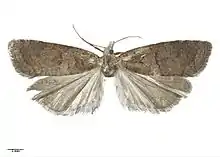| Epichorista tenebrosa | |
|---|---|
 | |
| Male | |
| Scientific classification | |
| Kingdom: | |
| Phylum: | |
| Class: | |
| Order: | |
| Family: | |
| Genus: | |
| Species: | E. tenebrosa |
| Binomial name | |
| Epichorista tenebrosa | |
Epichorista tenebrosa is a species of moth in the family Tortricidae. This species is endemic to New Zealand. It is found in Otago and has been collected in tussock grassland habitats. It is a late autumn emerging moth and adults are on the wing in February. It is classified as "At Risk, Relict'" by the Department of Conservation.
Taxonomy
This species was first described by Alfred Philpott in 1917 from a specimen collected at Ben Lomond by Charles E. Clarke in February.[2][3] George Hudson discussed and illustrated this species in his 1928 book The Butterflies and Moths of New Zealand.[4] The genus level classification of New Zealand endemic moths within Epichorista is regarded as unsatisfactory and is under revision.[5] As such this species is currently also known as Epichorista (s.l.) tenebrosa.[1] The type specimen is held at the Auckland War Memorial Museum.[3]
Description
.jpg.webp)
Philpott described the species as follows:
♂︎ 25-28 mm. ; ♀︎ 22 mm. Head and palpi ochreous-grey mixed with brown, palpi 3. Antennal ciliations of ♂︎ 1+1⁄2. Thorax purplish-brown sprinkled with brown. Abdomen ochreous-grey. Forewings elongate-triangular in ♂︎, suboblong in ♀︎, costa almost straight, without fold, apex obtuse, termen subsinuate, hardly oblique ; dull grey-brawn with purplish gloss and numerous obscure strigulations of reddish or fuscous ; margin of basal patch usually indicated by a more pronounced irregular strigula ; median fascia from 1⁄3 costa, irregular, outwardly oblique, inner margin only marked : cilia grey mixed with brown. Hindwings fuscous-grey, obscurely mottled with darker : cilia grey with darker basal line.[2]
Distribution

This species is endemic to New Zealand.[6] It is found in the Otago. As well as its type locality, this species has also been found in Naseby State Forest, at Roaring Meg and South Rough Ridge Hill.[7]
Behaviour
This species is a late autumn emerging moth.[8] It is on the wing in February.[4]
Habitat
Hudson noted that the type specimen was found at an altitude of 4000 ft in tussock grasslands.[4] The species has subsequently been collected from similar habitat.[7]
Conservation status
This moth is classified under the New Zealand Threat Classification system as being "At Risk, Relict".[9]
References
- 1 2 "Epichorista tenebrosa Philpott, 1917". www.nzor.org.nz. Landcare Research New Zealand Ltd. Retrieved 2018-05-17.
- 1 2 Philpott, A. (1917). "Descriptions of new species of Lepidoptera". Transactions and Proceedings of the New Zealand Institute. 49: 239–245. Retrieved 17 May 2018.
- 1 2 Dugdale, J. S. (1988). "Lepidoptera - annotated catalogue, and keys to family-group taxa" (PDF). Fauna of New Zealand. 14: 123. Retrieved 16 May 2018.
- 1 2 3 Hudson, G. V. (1928). The Butterflies and Moths of New Zealand. Wellington: Ferguson & Osborn Ltd. p. 237. OCLC 25449322.
- ↑ Patrick, Brian (2014-12-01). "Conservation status of five data deficient moth taxa: Epichorista lindsayi, "Cnephasia" paterna, Stathmopoda endotherma, Gymnobathra ambigua and Scythris "stripe"". The Weta. 48: 15–34.
- ↑ Gordon, Dennis P., ed. (2010). New Zealand inventory of biodiversity: Kingdom animalia: chaetognatha, ecdysozoa, ichnofossils. Vol. 2. p. 464. ISBN 978-1-877257-93-3. OCLC 973607714. OL 25288394M. Wikidata Q45922947.
- 1 2 Barratt, B. I. P.; Patrick, B. H. (1987). "Insects of snow tussock grassland on the East Otago Plateau". New Zealand Entomologist. 10 (1): 69–98. doi:10.1080/00779962.1987.9722513. Retrieved 17 May 2018.
- ↑ "Lammermoor Windfarm Decision" (PDF). www.qldc.govt.nz. Environment Court of New Zealand. 2009. Retrieved 17 May 2018.
- ↑ Hoare, R.J.B.; Dugdale, J.S.; Edwards, E.D.; Gibbs, G.W.; Patrick, B.H.; Hitchmough, R.A.; Rolfe, J.R. (2017). Conservation status of New Zealand butterflies and moths (Lepidoptera), 2015 (PDF). Wellington, New Zealand: New Zealand Department of Conservation. p. 8. ISBN 9781988514383.
